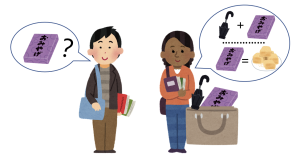Module 41.1 Dialogue
Title
Johnson presents Yamada with a souvenir from Kyoto

| Language | Script & Translation |
Japanese |
|
Romanization |
1 Yamada: Kaban no naka ni nani ga arimasu ka?
2 Jonson: Kasa ga arimasu. Omiyage mo arimasu. Hai, douzo. 3 Yamada: Aa, sumimasen. Kore wa nan desu ka? 4 Jonson: Warabimochi desu. Kyouto no meibutsu desu. Oishii desu yo. |
English translation |
1 Yamada: What is in the bag?
2 Johnson: There is an umbrella. There is also a souvenir. Here you are. 3 Yamada: Oh, thank you. What is this? 4 Johnson: This is warabimochi. This is a famous product from Kyoto. It is delicious, you know! |
Dialogue 1 Vocabulary
More Useful Words
Grammar Notes
| Location words: 上 (ue), 下 (shita), 中 (naka), 前 (mae), and 後ろ (ushiro) |
These Japanese words describe different positions or directions in space.
| 上 (ue) | up or above | to indicate something is in a higher position or above something else |
| 下 (shita) | down or below | to indicate something is in a lower position or below something else |
| 中 (naka) | inside or middle | to indicate something is inside or in the middle of something else |
| 前 (mae) | in front of or before | to indicate something is in front of another thing or person |
| 後ろ (ushiro) | behind, back | to indicate something is behind another thing or person |
| How to put 上 (ue),下 (shita), 中 (naka), 前 (mae), and 後ろ (ushiro) in a phrase or sentence |
| 机の上 | tsukue no ue | on top of the desk (lit. desk’s top) |
| 机の上 に本があります。 | tsukue no ue ni hon ga arimasu. | On top of the desk, there is a book. |
| 机の下 | tsukue no shita | under the desk (lit. desk’s under) |
| 机の下 に本があります。 | tsukue no shita ni hon ga arimasu. | Under the desk, there is a book. |
| 箱の中 | hako no naka | inside the box (lit. box’s inside) |
| 箱の中 に本があります。 | hako no naka ni hon ga arimasu. | Inside the box, there is a book. |
| 私の前 | watashi no mae | in front of me (lit. my front) |
| 私の上 に本があります。 | watashi no mae ni hon ga arimasu. | In front of me, there is a book. |
| 私の後ろ | watashi no ushiro | behind me (lit. my back) |
| 私の後ろに本があります。 | watashi no ushiro ni hon ga arimasu. | Behind me, there is a book. |
In summary,
- 上, 下, 中, 前, and 後ろare used to describe the spatial relationship between objects or people. By using them properly, you can communicate about the locations more precisely in Japanese.
- Note 上, 下, 中, 前, and 後ろ follow the word that describes the “larger” area or reference word. In addition, の is used to connect the larger area and the location words as seen in 机の上, 机の下, 箱の中, 私の前, 私の後ろ
- Note particle に is used after specific locations as in 机の上, 机の下, 箱の中, 私の前, 私の後ろ to describe at, in, or on these locations (someone or something exists).
That is, we use the following sentence patterns to describe at (in, or on) a location, something, some animal, or someone exists.
| Location | に | thing | が | あります。 |
| Location | に | person or animal | が | います。 |
If one would like to know what, what animal, or who is at a location, the questions are as follows, respectively:
| Location | に | 何 (nani; what) | が | ありますか。 |
| At this location, what object exists? (or At this location, what object is there?) | ||||
| Location | に | 何 (nani; what) | が | いますか。 |
| At this location, what animal exists? (or At this location, what animal is there?) | ||||
| Location | に | 誰 (dare; who) | が | いますか。 |
| At this location, who exists? (or At this location, who is there?) | ||||
When answering the questions, replace 何 with the name of the object or animal or 誰 with the exact person.
やまだ
かばん
なか
なに
かさ
みやげ
なん
きょうと
めいぶつ
うえ
した
まえ
うし
つくえ
はこ
わたし
あと
だれ
